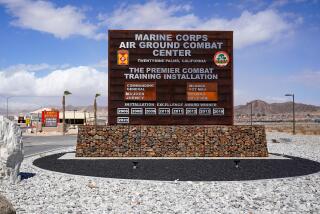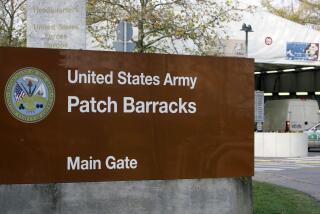Military Bases Brace for Possible Terrorist Acts : Security: Vigilance is increased as the Tuesday deadline approaches and the country nears a possible war.
Security at Orange County, San Diego and other California military bases has heightened as local officials brace for potential terrorist attacks and the country veers toward a possible war, Pentagon officials said Friday.
At Navy bases across the state, officials have issued a “condition alpha,” or a low-level security alert. From installation to installation, actual security precautions will vary but at very least, guards are more carefully monitoring people coming on base, the cars they drive and the packages they tote.
“There are a wide variety of security measures that can be taken. It might be simply increasing the checks or increasing the actual presence of security,” said Lt. Col. Steve Roy, a Pentagon spokesman. “Obviously, world events do affect security requirements at local installations.”
In California, the concern has intensified because of an incident that occurred earlier this week outside a Fresno Navy recruiting station where a female petty officer 1st class was attacked by a man wielding a knife. The assailant, described as Arab, held a knife to the petty officer’s throat and yelled, “On the 15th, you will die.”
The woman was treated for minor cuts; the attacker escaped. In the wake of the attack, alerts have been issued to all recruiting stations as well as the military installations, said Cmdr. Tommy Atkins, chief staff officer for Naval Recruiting Area 8, a region covering 10 states.
At bases, vigilance has become widespread.
At El Toro Marine Corps Air Station, officers have begun changing into civilian clothes before leaving the base so they cannot be readily identified as military personnel.
At the Seal Beach Naval Weapons Station, security personnel have increased patrols around the 5,000-acre facility and closer attention is being paid to those entering the base, including employees and their identification cards.
“Because we are a weapons station we already have stringent security,” said Tom Thomas, the base’s public information officer. The base serves more than 300 ships a year and handles everything from .45-caliber bullets to missiles and 16-inch projectiles for battleships. “But we are now being extra cautious. There is a lot closer scrutiny of visitors and our perimeter.”
Thomas said base security also is sharing intelligence and any reports about suspicious activity with local law enforcement agencies.
Similarly, precautions have have been increased at the U.S. Army Reserve Center in Los Alamitos. The base is home to about 4,300 reservists and has a large airfield.
“About all I can say is that we have increased our security posture at the installation,” said Army Maj. Carl D. Lawrence, a spokesman for the base. He said he could not discuss specifics for safety reasons.
At El Toro and Tustin Marine Corps air stations in Orange County, security has been stepped up throughout both installations and more scrutiny is being given to visitors. Specifics about the efforts were not available, however.
“We can’t ignore the Jan. 15 deadline,” said Marine Capt. Betsy A. Sweatt, the public affairs officer at El Toro, which is home to the 3rd Marine Air Wing. “We are acutely aware of our security right now and prepared to increase our levels as the situation demands.”
About 10,000 to 13,000 Marines are stationed at the helicopter facility in Tustin and in El Toro, where a large portion of the corps’ jet fighters and transports are based. Those bases did not report any suspicious incidents on their grounds or outside.
In San Diego, traffic has begun to back up at naval bases as security guards check identification cards, as well as verifying decals on cars. At the Long Beach Naval Ship Yard, a 10-year veteran photographer for The Times was detained for an hour by base police who cited security concerns after spotting him taking a pre-approved picture of the facility.
A regional security advisory was issued this week to Navy bases warning of an Iraqi national who failed to appear in court after being arrested for forging prescriptions in San Luis Obispo. Authorities found a pistol-grip 12-gauge shotgun, 20 unspent shells, an explosive device, 50 credit cards, and receipts for round-trip travel from San Francisco to London in the car belonging to Duraid Sadio Jahbarazowi.
The 35-year-old Baghdad native had told police that his father is an Iraqi Air Force general.
According to the advisory, Jahbarazowi--considered armed and dangerous--should be detained if observed and held at a distance from his car, which should be treated as though it were an explosive device. There is, however, no indication that Jahbarazowi intends to target a military base, nor is it clear why the Iraqi national was released on bail. Officials say the advisory fits in with the general alert.
“No one says it’s a terrorist but you have to question what his motivation is and what his activities might be,” said Dennis Usrey, regional director of the Naval Investigative Service, the detective arm of the Navy. “We are certainly being particularly alert for any possible targeting or any particular interest in Navy activities that might relate to a threat.”
There are four levels of security alerts, graded in alphabetical code ranging from least to most serious, from condition alpha to condition delta. In condition alpha, a general threat against military personnel or facilities is considered possible. In condition delta, an attack has occurred, is considered imminent, or armed intruders have been detected. It is not known when the last condition alpha was issued.
The 1983 bombing of Marine barracks outside Beirut, in which 241 U.S. servicemen were killed, served as a painful lesson to military officials about the hazards of lax security.
“It is the legacy of the bombing of the Marine barracks that no one in the military wants to be caught with the same degree of vulnerability,” said Bruce Hoffman, associate director of the RAND Corp.’s International Security and Defense Strategy Program. “In general, the threat to U.S. military facilities is obviously far greater in the Persian Gulf and elsewhere than it is in the U.S. But this is a very different conflict and terrorism has been institutionalized as a weapon of warfare.”
Navy officials across Southern California were reluctant to spell out exactly what security precautions were being taken.
“Let’s just say we are being a lot more careful of the way we do business,” said Ken Mitchell, spokesman for the North Island Naval Air Station in San Diego.
While completing already-scheduled tours, Navy officials will not conduct future tours of aircraft carriers and other vessels stationed at North Island after next week, said spokesman Senior Chief Petty Officer Bob Howard.
Times staff writer Dan Weikel contributed to this report.
More to Read
Sign up for Essential California
The most important California stories and recommendations in your inbox every morning.
You may occasionally receive promotional content from the Los Angeles Times.










